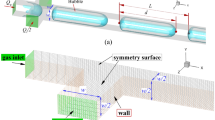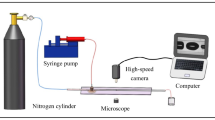Abstract
The present study aims at scaling the formation of slug bubbles in flow-focusing microfluidic devices using a high-speed digital camera and a micro particle image velocimetry (μ-PIV) system. Experiments were conducted in two different polymethyl methacrylate square microchannels of respectively 600 × 600 and 400 × 400 μm. N2 bubbles were generated in glycerol–water mixtures with several concentrations of surfactant sodium dodecyl sulfate. The influence of gas and liquid flow rates, the viscosity of the liquid phase and the width of the microchannel on the bubble size were explored. The bubble size was correlated as a function of the width of the microchannel W c, the ratio of the gas/liquid flow rates Q g/Q l and the liquid Reynolds number. During the pinch-off stage, the variation of the minimum width of the gaseous thread W m with the remaining time could be scaled as \( W_{\text{m}} \propto ({\frac{{Q_{\text{g}} }}{{Q_{\text{l}} }}})^{ - 0.15} (T - t)^{1/3} . \) The velocity fields in the liquid phase around the thread, determined by μ-PIV measurements, were obtained around a forming bubble to reveal the role of the liquid phase.







Similar content being viewed by others
Abbreviations
- Q g :
-
Gas volumetric flow rate, mm3 s−1
- Q l :
-
Liquid volumetric flow rate, mm3 s−1
- L :
-
Bubble length, μm
- l o :
-
Orifice length between the junction and the exit chamber, μm
- T :
-
Bubble formation period, ms
- t :
-
Time, ms
- u :
-
Average liquid flow velocity, m s−1
- u m :
-
Characteristic two-phase flow velocity, m s−1
- V :
-
Bubble volume, m3
- W c :
-
Microchannel width, μm
- W g :
-
Microchannel width for gas inlet, μm
- W l :
-
Microchannel width for liquid inlet, μm
- W m :
-
Maximum (when the neck radius is greater than the microchannel width) or minimum (when the neck radius is smaller than the microchannel width) width of the gaseous thread, μm
- W o :
-
Width of orifice between the junction and the exit chamber, μm
- W out :
-
Width of out chamber, μm
- μ :
-
Viscosity, mPa s
- ρ :
-
Density, kg m−3
- σ :
-
Surface tension, mN m−1
- θ :
-
Angle between the gas and liquid inducing channel °
- Re :
-
Liquid Reynolds number, (= ρuW c/μ)
- g :
-
Gas
- l :
-
Liquid
References
Burton JC, Waldrep R, Taborek P (2005) Scaling and instabilities in bubble pinch-off. Phys Rev Lett 94:184502
Cubaud T, Tatineni M, Zhong X, Ho CM (2005) Bubble dispenser in microfluidic devices. Phys Rev E 72:037302
Dietrich N, Poncin S, Midoux N, Li HZ (2008) Bubble formation dynamics in various flow-focusing microdevices. Langmuir 24:13904–13911
Dollet B, van Hoeve W, Raven JP, Marmottant P, Versluis M (2008) Role of the channel geometry on the bubble pinch-off in flow-focusing devices. Phys Rev Lett 100:034504
Figeys D, Pinto D (2000) Lab-on-a-chip: a revolution in biological and medical sciences. Anal Chem 72:330–335
Frank X, Funfschilling D, Midoux N, Li HZ (2006) Bubbles in a viscous liquid: lattice Boltzmann simulation and experimental validation. J Fluid Mech 546:113–122
Fu T, Ma Y, Funfschilling D, Li HZ (2009) Bubble formation and breakup mechanism in a microfluidic flow-focusing device. Chem Eng Sci 64:2392–2400
Gañán-Calvo AM, Gordillo JM (2001) Perfectly monodisperse microbubbling by capillary flow focusing. Phys Rev Lett 87:274501
Garstecki P, Gitlin I, Diluzio W, Kumacheva E, Stone HA, Whitesides GM (2004) Formation of monodisperse bubbles in a microfluidic flow-focusing device. Appl Phys Lett 85:2649–2651
Garstecki P, Stone HA, Whitesides GM (2005) Mechanism for flow-rate controlled breakup in confined geometries: a route to monodisperse emulsions. Phys Rev Lett 94:164501
Garstecki P, Fuerstman MJ, Stone HA, Whitesides GM (2006) Formation of droplets and bubbles in a microfluidic T-junction: scaling and mechanism of break-up. Lab Chip 6:437–446
Go JS, Shoji S (2003) Digital sorting of flow-through droplet phase microfluid. Jpn J Appl Phys 42:448–450
Gordillo JM, Cheng Z, Ganan-Calvo AM, Marquez M, Weitz DA (2004) A new device for the generation of microbubbles. Phys Fluids 16:2828–2834
Günther A, Jhunjhunwala M, Thalmann M, Schmidt MA, Jensen KF (2005) Micromixing of miscible liquids in segmented gas–liquid flow. Langmuir 21:1547–1555
Hong Y, Wang F (2007) Flow rate effect on droplet control in a co-flowing microfluidic device. Microfluid Nanofluidics 3:341–346
Jensen MJ, Stone HA, Bruus H (2006) A numerical study of two-phase stokes flow in an axisymmetric flow-focusing device. Phys Fluids 18:077103
Kreutzer MT, Kapteijn F, Moulijn JA, Heiszwolf JJ (2005) Multiphase monolith reactors: chemical reaction engineering of segmented flow in microchannels. Chem Eng Sci 60:5895–5916
Lao KL, Wang JH, Lee GB (2009) A microfluidic platform for formation of double-emulsion droplets. Microfluid Nanofluidics. doi:10.1007/s10404-009-0430-9
Li HZ, Mouline Y, Midoux N (2002) Modelling the bubble formation dynamics in non-Newtonian fluids. Chem Eng Sci 57:339–346
Litterst C, Metz T, Zengerle R, Koltay P (2008) Static and dynamic behavior of gas bubbles in T-shaped non-clogging micro-channels. Microfluid Nanofluidics 5:775–784
Skurtys O, Bouchon P, Aguilera JM (2008) Formation of bubbles and foams in gelatine solutions within a vertical glass tube. Food Hydrocolloid 22:706–714
Song H, Chen DL, Ismagilov RF (2006) Reactions in droplets in microfluidic channels. Angew Chem 45:7336–7356
van Steijn V, Kreutzer MT, Kleijn CR (2007) μ-PIV study of the formation of segmented flow in microfluidic T-junctions. Chem Eng Sci 62:7505–7514
Wang K, Lu YC, Xu JH, Tan J, Luo GS (2008) Liquid–liquid micro-dispersion in a double-pore T-shaped microfluidic device. Microfluid Nanofluidics. doi:10.1007/s10404-008-0332-2
Weber MW, Shandas R (2007) Computational fluid dynamics analysis of microbubble formation in microfluidic flow-focusing devices. Microfluid Nanofluidics 3:195–206
Xiong R, Bai M, Chung JN (2007) Formation of bubbles in a simple co-flowing micro-channel. J Micromech Microeng 17:1002–1011
Xu JH, Li SW, Chen GG, Luo GS (2006) Formation of monodisperse microbubbles in a microfluidic device. AIChE J 52:2254–2259
Yan D, Yang C, Nguyen NT, Huang X (2007) Diagnosis of transient electrokinetic flow in microfluidic channels. Phys Fluids 19:017114
Yasuno M, Sugiura S, Iwamoto S, Nakajima M, Shono A, Satoh K (2004) Monodispersed microbubble formation using microchannel technique. AIChE J 50:3227–3233
Yen BKH, Günther A, Schmidt MA, Jensen KF, Bawendi MG (2005) A microfabricated gas–liquid segmented flow reactor for high-temperature synthesis: the case of CdSe quantum dots. Angew Chem 44:5447–5451
Yu Z, Hemminger O, Fan L-S (2007) Experiment and lattice Boltzmann simulation of two-phase gas–liquid flows in microchannels. Chem Eng Sci 62:7172–7183
Zhang H, Tumarkin E, Peerani R, Nie Z, Sullan RMA, Walker GC, Kumacheva E (2006) Microfluidic production of biopolymer microcapsules with controlled morphology. J Am Chem Soc 128:12205–12210
Acknowledgments
The financial support for this project from the National Nature Science Foundation of China (No 20876107), the aid of Opening Project of State Key Laboratory of Chemical Engineering (Grant No SKL-ChE-08B06) and the Program of Introducing Talents of Discipline to Universities (Grant No B06006) are gratefully acknowledged. T. Fu appreciates the financial aid from both the China Scholarship Council and the French Embassy in China.
Author information
Authors and Affiliations
Corresponding author
Rights and permissions
About this article
Cite this article
Fu, T., Funfschilling, D., Ma, Y. et al. Scaling the formation of slug bubbles in microfluidic flow-focusing devices. Microfluid Nanofluid 8, 467–475 (2010). https://doi.org/10.1007/s10404-009-0471-0
Received:
Accepted:
Published:
Issue Date:
DOI: https://doi.org/10.1007/s10404-009-0471-0




